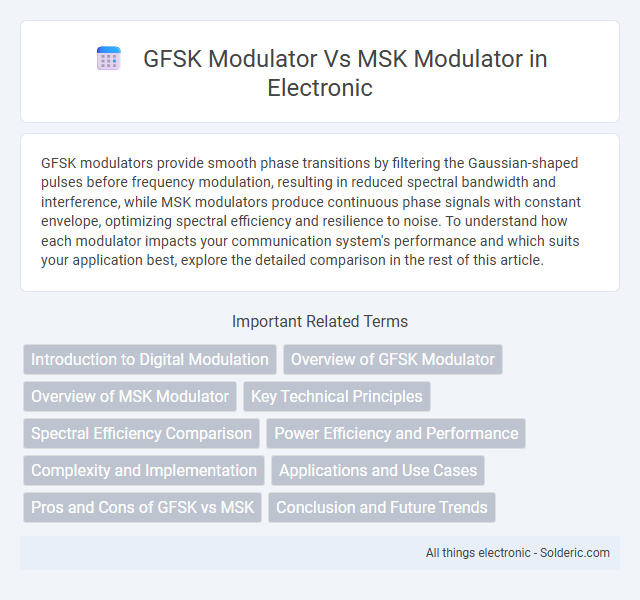GFSK modulators provide smooth phase transitions by filtering the Gaussian-shaped pulses before frequency modulation, resulting in reduced spectral bandwidth and interference, while MSK modulators produce continuous phase signals with constant envelope, optimizing spectral efficiency and resilience to noise. To understand how each modulator impacts your communication system's performance and which suits your application best, explore the detailed comparison in the rest of this article.
Comparison Table
| Feature | GFSK Modulator | MSK Modulator |
|---|---|---|
| Modulation Type | Gaussian Frequency Shift Keying | Minimum Shift Keying |
| Frequency Deviation | Gaussian filtered, variable deviation | Constant deviation, minimum frequency shift |
| Spectral Efficiency | High, due to Gaussian filtering | Very High, minimum shift reduces bandwidth |
| Phase Continuity | Smooth, reduces sidebands | Continuous phase modulation |
| Bit Error Rate (BER) | Moderate, depends on Gaussian filter bandwidth | Lower BER thanks to constant envelope |
| Complexity | Moderate complexity due to filtering | Simple, efficient modulator and demodulator |
| Applications | Bluetooth, low-power RF devices | Wireless communications, cellular systems |
| Power Efficiency | Good, but less than MSK | High power efficiency with constant envelope |
Introduction to Digital Modulation
GFSK modulator uses Gaussian filtering of the digital data before frequency shift keying, minimizing bandwidth and reducing interference in wireless communication. MSK modulator employs a continuous phase frequency modulation with a modulation index of 0.5, ensuring constant envelope and improved spectral efficiency. Both modulators serve crucial roles in digital communication systems, with GFSK favored for Bluetooth technology and MSK commonly applied in satellite and military communications.
Overview of GFSK Modulator
GFSK (Gaussian Frequency Shift Keying) modulator uses a Gaussian filter to smooth the frequency transitions, reducing bandwidth and minimizing interference in wireless communication systems. Its continuous-phase modulation enhances spectral efficiency and lowers adjacent channel interference compared to traditional FSK modulators. GFSK modulators are widely employed in Bluetooth and other low-power RF applications due to their balance between performance and implementation complexity.
Overview of MSK Modulator
MSK modulator offers continuous phase frequency modulation, which results in a constant envelope signal and reduced spectral sidelobes compared to GFSK. It provides better spectral efficiency and lower bit error rates, making it suitable for high-performance communication systems. Your choice of MSK modulator improves signal robustness in multipath and fading environments.
Key Technical Principles
GFSK modulator uses Gaussian filtering to smooth the frequency pulses, reducing bandwidth and minimizing intersymbol interference, making it ideal for bandwidth-efficient communications like Bluetooth. MSK modulator employs continuous phase frequency shifting with a constant envelope, ensuring minimal phase discontinuities and improved spectral efficiency, commonly used in digital cellular systems. Your choice depends on the balance between spectral efficiency and implementation complexity required for the application.
Spectral Efficiency Comparison
GFSK modulators provide moderate spectral efficiency by using continuous-phase frequency shifts that limit sideband emissions, making them suitable for bandwidth-constrained applications. MSK modulators offer higher spectral efficiency through more precise phase continuity and minimal frequency deviation, resulting in lower out-of-band emissions and improved bandwidth utilization. Your system benefits from MSK modulation when demanding tighter spectral masks and enhanced data throughput within limited frequency resources.
Power Efficiency and Performance
GFSK modulators offer better power efficiency compared to MSK modulators due to their constant envelope nature, which allows for non-linear amplifiers with lower power consumption. MSK modulators provide superior performance in terms of spectral efficiency and error rates, making them ideal for applications requiring high data integrity and bandwidth efficiency. Your choice depends on whether power saving or signal performance is the top priority in your wireless communication system.
Complexity and Implementation
GFSK modulators offer lower complexity with simpler hardware requirements, making them suitable for low-power and resource-constrained applications, while MSK modulators demand more intricate implementation due to continuous phase constraints and require precise timing control. GFSK can be efficiently implemented using phase-locked loops or frequency synthesizers, whereas MSK often involves complex digital signal processing algorithms for phase continuity and spectral efficiency. The choice between GFSK and MSK modulators hinges on balancing implementation complexity against performance benefits in spectral efficiency and robustness.
Applications and Use Cases
GFSK modulators are widely used in low-power wireless communication systems such as Bluetooth and Zigbee due to their spectral efficiency and resilience to interference. MSK modulators are preferred in high-speed data transmission applications like GSM cellular networks because of their constant envelope and superior phase continuity, which reduce signal distortion. Your choice between GFSK and MSK modulators depends on the specific requirements of power consumption, data rate, and signal integrity in your communication system.
Pros and Cons of GFSK vs MSK
GFSK modulators offer simplicity and robustness with lower spectral side lobes, making them suitable for low-power wireless devices, but may suffer from higher inter-symbol interference compared to MSK. MSK modulators provide constant envelope modulation and excellent spectral efficiency, reducing bit error rates in multipath environments, though they demand more complex implementation and higher computational resources. Your choice depends on balancing power efficiency and system complexity against spectral performance and error resilience.
Conclusion and Future Trends
GFSK modulators offer simpler implementation and better spectral efficiency, making them ideal for low-power wireless communication systems, while MSK modulators provide improved performance in terms of error rates due to their continuous phase properties. Future trends indicate a growing integration of these modulation techniques in hybrid systems to leverage the power efficiency of GFSK and the robustness of MSK in 5G and IoT applications. Your choice between GFSK and MSK modulator will depend on the specific trade-offs between complexity, power consumption, and communication reliability required in emerging wireless technologies.
GFSK modulator vs MSK modulator Infographic

 solderic.com
solderic.com